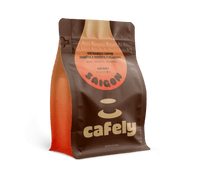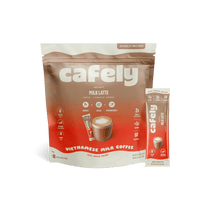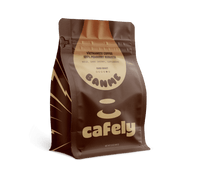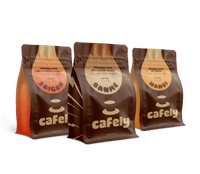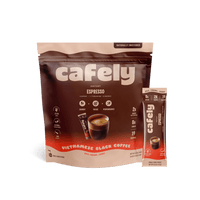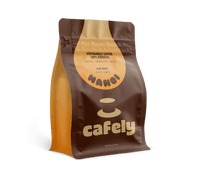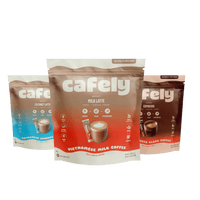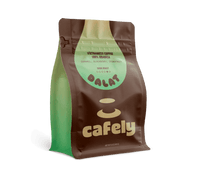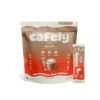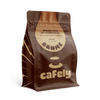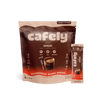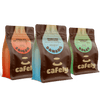The general definition of a single espresso is one ounce, and a double is two. However, modern espresso culture doesn’t use this measurement as much as it used to, as there are other methods that are more popular.
In this article, we break down exactly how big an espresso is and go over the different sizes and ratios that can make a tastier cup.
How Many Ounces Is a Shot of Espresso? Standard Measurements
Well, a shot of espresso is generally defined as one fluid ounce, and a double espresso is two fluid ounces.
Espresso coffee is a beautiful thing, packing flavor, history, and culture into that tiny portion. Unfortunately, there are some minor issues with those measurements.
Fluid Ounces
Fluid ounces measure volume instead of weight. This might sound unimportant, but it means that an espresso with extra dissolved solids and crema is the same size as one without those extras, but offers a very different experience.
This leads to inconsistencies when brewing, and makes it harder to replicate a particularly great cup.
Grams
A better way is to use grams for all measurements when brewing, combined with brewing ratios so you can repeat the recipe. Brewing ratios are a way of representing how much ground coffee you use against how much brewed espresso is produced.
For instance, a 1:2 ratio for an espresso could use around 20 grams of coffee and yield around 40 grams of espresso.
This all sounds a little complex, so let’s break it down with a convenient table.
Brewing Ration Table

The reason we have these different measurements is that they result in different tastes and textures in the final cup.
A single and double espresso can be quite similar in flavor and texture; there’s just more liquid (and more caffeine) in the double.
A ristretto has a stronger flavor than a standard espresso, and a lungo makes use of additional water to create a smoother, milder flavor.
Other Factors Can Influence Espresso’s Size
When brewing great espresso, the ratio of coffee to water is only half the battle. You have to get other factors right so the coffee is as flavorsome as possible.
Generally, baristas aim to have a shot (1:2 ratio) draw around 1.5 ounces (40 grams) of liquid in around thirty seconds. Through lots of experimenting, coffee lovers have found that these numbers achieve a consistently great flavor and texture.
To get to these goal numbers, baristas manage time, pressure, and temperature — or have machines that do it for them. High-end espresso machines preset the temperature, time, and pressure so we don’t have to.
These other factors are often considered more important than the exact size of the shot.
How Shot Sizes Vary by Region & Café Style
The truth of espresso shot sizes is that there’s a lot of variety in what’s considered “standard.” Depending upon where and how you order coffee, you could get a very small ristretto or a larger-than-usual lungo.
A classic example of this is the difference between Italian espresso culture and US espresso culture. In Italy, it’s common to use around 12–14 grams of coffee to make a traditional 30 mL shot of espresso, which is one ounce. American cafes, however, tend to make slightly larger shots and use more coffee to do so.
This attitude of creating larger shots and using higher brew ratios is prevalent in third-wave coffee shops. There, baristas might use around 18–20 grams of coffee to make a brew of 30–40 grams of espresso. Altering the ratio like this can give an espresso a complex, punchy, and nuanced flavor.
Finally, chain coffee stores often have their own internal guidelines for making espresso. For instance, Starbucks espresso shots are 22 mL, or 0.75 oz. Their brewing method is designed to be as consistent as possible for repeat business, hence the slightly unusual way of doing things.
Espresso-Style Coffee
As well as the differences between espressos from various locations, it's also important to consider espresso-adjacent coffee.
Espresso machines have gone through a lot of changes, with the first machine (invented in 1884) being a steam-powered machine that produced coffee in bulk — that's very different from our modern-day machine.
Plenty of iterations and offshoots have been explored along the way, and all produce coffee similar to espresso, but none quite hit the mark.
Moka Pot
For example, a typical moka pot produces coffee that’s very similar to espresso. The brewing method itself is superficially similar, in that you add coffee to a filter, and water is forced through it to create a strong cup.
It’s different from espresso in that the pressure applied to the coffee comes from the water expanding as it boils, so the brewing occurs at a higher temperature, often leading to quite bitter coffee.
The brew ratio is also different, sometimes including around 15 grams of ground coffee and around 200 mL of brewed coffee, served in portions of around 60 mL.
A moka pot’s coffee is quite different from espresso, but if you’re looking for a similar flavor profile served in a larger cup, it could be an ideal option to select from the top coffee picks for moka pot.
Aeropress + Fellow Prismo
Another example of espresso-style coffee is the brews made using the Fellow Prismo. This is a small attachment for the Aeropress, which uses a fine mesh filter and a very small nozzle to increase pressure on the coffee grounds.
While no espresso machine is used for this brewing style, the small, potent coffee it makes is certainly espresso-like.
Since the Prismo uses an Aeropress, you’re free to brew as much or as little “espresso” as you’d prefer. The body of the Aeropress can hold around 300 mL of water, so you could make a huge drink compared to a traditional espresso.
Single vs. Double Espresso Shots: What’s the Difference?

The only difference between a single and double espresso is volume: a double uses twice the grounds and produces twice the coffee.
Most cafés default to a double for milk-based drinks like lattes, since the stronger flavor cuts through the milk.
You can always ask for a single instead, which makes for a smoother, creamier drink with less caffeine — usually at no extra cost.
How Espresso Shot Size Affects Caffeine Content
The amount of caffeine in your espresso is directly influenced by the amount of coffee used to make it. So, smaller shots that use less coffee will have less caffeine overall.
Here’s a rundown of the approximate amount of caffeine in different shot sizes.
- Single — 63 mg of caffeine.
- Double — 125 mg of caffeine.
- Ristretto — 50–60 mg of caffeine. Because the extraction time is shorter, less caffeine makes its way into the final drink.
- Lungo — 130–135 mg of caffeine. More water passes through the same amount of coffee, so slightly more caffeine can be extracted.
How to Brew Great Espresso
Brewing espresso is a fascinating discipline — easy to learn, impossible to master. Here, we break down the basic method and then give you some hot tips!
- Weigh and grind the beans — Start by weighing the beans you'll use. For a standard espresso ratio of 1:2, you'll usually aim for around 30 grams of dark-roasted coffee beans. Add those beans to your grinder and grind finely.
- Tamp and set the portafilter — Once the grounds are in the portafilter, use a tamper to press them down into a flat bed of coffee. This ensures even water distribution and a more balanced flavor. Then, twist the portafilter into place under the group head.
- Draw a shot — Many machines have different mechanisms for drawing shots of espresso, so follow the instruction manual. If your machine doesn't dispense a set amount of water and has a stop/start button, draw the shot for around thirty seconds before switching the machine off.
- Break up the crema (optional) — Once the espresso is in the cup, use a small spoon to break up the crema on top. Distributing the foam into the drink can distribute flavoring oils into the coffee more evenly, though some people prefer it unstirred.
- Enjoy — Finally, it’s time to enjoy the espresso. Something wonderful about the drink is that it’s best served very fresh, so drink it quickly.
Espresso Hot Tips
There are several things to bear in mind when making espresso. Here are some of our hot tips to brew at your best!
- Keep Your Machine Clean — A clean machine will impart the minimum amount of contaminants into your coffee, so regularly clean and purge.
- Distribute Your Grounds Evenly — For even flavor in the cup, the goal is to have all the water pass through all of the coffee. To make this happen, use a fine, pointed tool to break up any clumps that could cause issues.
- Tamp Well for Good Pressure — To achieve optimum pressure while brewing, good tamping is essential. Aim to press with around twenty to thirty pounds of force.
- Combine Arabica and Robusta — This isn’t for everyone, but there’s an Italian tradition of having your espresso beans be 90% arabica and 10% robusta. Those who love this believe that the flavor is made richer and more finished by the addition of robusta beans.
Finding the Best Beans for Espresso
When brewing showstopping espresso, it’s key to remember that the best espresso comes from the best beans. For your coffee to be as good as it can be, you need to source premium beans and show off their best qualities.
Consider the beans and choose ones that sound good to you. While arabica is exceedingly popular, robusta is another great option for brewing espresso. The beans are traditionally roasted dark and ground fine for peak extraction, as with espresso. For an exciting foray into unique coffee, give them a try!
To find the best beans for espresso, take into account your personal preferences but also consider a few key factors that make beans better.
- Organic — Organic coffee beans don’t rely on human-made chemicals to produce a great crop. Instead, they’re simply strong, complex, and delicious plants in their own right.
- Single-origin — Coffee from a single origin can have very specific flavor notes that you return to repeatedly. Find an origin you enjoy, and explore what they offer.
- Mold-free — Some grain-like crops can experience mold growth during shipping, and coffee is one of them. For safe and clean coffee, always check that your beans are guaranteed mold-free.
- Fairtrade — The Fairtrade agreement allows farmers a guaranteed profit on their crop. Therefore, they can wait to sell their beans until they’re perfect, rather than rushing to get them to market.
- Freshly Roasted — Fresh coffee has the most flavor, as it goes stale over time. For the best brews, look for coffee that was roasted in the last two weeks.
FAQs: How Many Ounces Is a Shot of Espresso?
Now that we’ve delved into the complexities of great espresso, here are some key FAQs to clear up any remaining mysteries.
1. How Many Ounces Is an Espresso Shot?
A standard single espresso is one ounce, or 30 mL. However, many baristas and chain stores will have their own recipes and may make slightly more or less coffee.
2. What Is the Coffee to Water Ratio for Espresso?
Generally, baristas use a 1:2 ratio for espresso. For a standard double shot, this means a barista will use up to 30 grams of coffee and pull approximately 60 grams of espresso.
3. What Beans Should I Use for Espresso?

This is up to you and what you like, but espresso is typically made with dark roast coffee. It provides a rich, earthy, and bittersweet flavor perfect for espresso.
4. What’s Better for Espresso: Grams or Ounces?
Grams is the better unit of measurement for espresso, because they measure weight while ounces measure volume. Using a weight measurement means you get the same amount of espresso each time, while a volumetric measurement could be “tricked” by one shot having a thicker layer of crema than another.
5. How Much Water Is There in a Shot of Espresso?
A double shot (or doppio) of espresso is 60 mL of coffee. While some water is lost when it's absorbed into the coffee, the amount is minimal and we don't consider it in coffee math.
6. How Many Ounces Is One Shot of Espresso at Starbucks?
A Starbucks espresso is unusual in that it is 0.75 oz instead of the standard 1 oz. They brew this way to create a smaller shot with a more concentrated flavor.
7. What Does Shaking Espresso Do?
Shaking an espresso cools it down quickly while also diluting it by a very small amount. Plus, the ice impacting the coffee will mix it up well, creating a foamy texture as air is incorporated, and dissolving sugar and syrups into the brew.
8. How Long Does It Take to Pull a Shot?
Most espresso is brewed in around thirty seconds, but some baristas may allow slightly more or less time depending on their tastes.
9. What Is a Double Espresso With Milk Called?
Depending on how much milk you’re using, a doppio with milk could have lots of names. For instance, a latte uses a lot of milk alongside a double espresso, while a macchiato uses a very small amount, barely enough to cover the surface of the coffee.
10. How Much Espresso Is in a Latte?
Most espresso-based milk drinks like lattes are made with a double espresso, which represents about 60 mL of coffee in total. For a creamier latte with less of a caffeine kick, you can ask for a single espresso, which would equate to around 30 mL of coffee.
